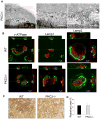Protein kinase C-delta deficiency perturbs bone homeostasis by selective uncoupling of cathepsin K secretion and ruffled border formation in osteoclasts
- PMID: 22806935
- PMCID: PMC3498518
- DOI: 10.1002/jbmr.1701
Protein kinase C-delta deficiency perturbs bone homeostasis by selective uncoupling of cathepsin K secretion and ruffled border formation in osteoclasts
Abstract
Bone homeostasis requires stringent regulation of osteoclasts, which secrete proteolytic enzymes to degrade the bone matrix. Despite recent progress in understanding how bone resorption occurs, the mechanisms regulating osteoclast secretion, and in particular the trafficking route of cathepsin K vesicles, remain elusive. Using a genetic approach, we describe the requirement for protein kinase C-delta (PKCδ) in regulating bone resorption by affecting cathepsin K exocytosis. Importantly, PKCδ deficiency does not perturb formation of the ruffled border or trafficking of lysosomal vesicles containing the vacuolar-ATPase (v-ATPase). Mechanistically, we find that cathepsin K exocytosis is controlled by PKCδ through modulation of the actin bundling protein myristoylated alanine-rich C-kinase substrate (MARCKS). The relevance of our finding is emphasized in vivo because PKCδ-/- mice exhibit increased bone mass and are protected from pathological bone loss in a model of experimental postmenopausal osteoporosis. Collectively, our data provide novel mechanistic insights into the pathways that selectively promote secretion of cathepsin K lysosomes independently of ruffled border formation, providing evidence of the presence of multiple mechanisms that regulate lysosomal exocytosis in osteoclasts.
Copyright © 2012 American Society for Bone and Mineral Research.
Conflict of interest statement
All the authors state that they have no conflicts of interest
Figures






Similar articles
-
V-ATPase subunit ATP6AP1 (Ac45) regulates osteoclast differentiation, extracellular acidification, lysosomal trafficking, and protease exocytosis in osteoclast-mediated bone resorption.J Bone Miner Res. 2012 Aug;27(8):1695-707. doi: 10.1002/jbmr.1623. J Bone Miner Res. 2012. PMID: 22467241 Free PMC article.
-
Actin-binding protein coronin 1A controls osteoclastic bone resorption by regulating lysosomal secretion of cathepsin K.Sci Rep. 2017 Mar 16;7:41710. doi: 10.1038/srep41710. Sci Rep. 2017. PMID: 28300073 Free PMC article.
-
Specific biological functions of vacuolar-type H(+)-ATPase and lysosomal cysteine proteinase, cathepsin K, in osteoclasts.Anat Rec A Discov Mol Cell Evol Biol. 2003 Feb;270(2):152-61. doi: 10.1002/ar.a.10020. Anat Rec A Discov Mol Cell Evol Biol. 2003. PMID: 12524690
-
[Osteoclasts in bone metabolism].Kaibogaku Zasshi. 1991 Aug;66(4):215-25. Kaibogaku Zasshi. 1991. PMID: 1759556 Review. Japanese.
-
V-ATPase a3 Subunit in Secretory Lysosome Trafficking in Osteoclasts.Biol Pharm Bull. 2022;45(10):1426-1431. doi: 10.1248/bpb.b22-00371. Biol Pharm Bull. 2022. PMID: 36184499 Review.
Cited by
-
Osteoimmunology: A Current Update of the Interplay Between Bone and the Immune System.Front Immunol. 2020 Jan 31;11:58. doi: 10.3389/fimmu.2020.00058. eCollection 2020. Front Immunol. 2020. PMID: 32082321 Free PMC article. Review.
-
In vitro model of bone to facilitate measurement of adhesion forces and super-resolution imaging of osteoclasts.Sci Rep. 2016 Mar 3;6:22585. doi: 10.1038/srep22585. Sci Rep. 2016. PMID: 26935172 Free PMC article.
-
Regulation of lysosome biogenesis and functions in osteoclasts.Cell Cycle. 2013 Sep 1;12(17):2744-52. doi: 10.4161/cc.25825. Epub 2013 Aug 5. Cell Cycle. 2013. PMID: 23966172 Free PMC article. Review.
-
Activin A inhibits RANKL-mediated osteoclast formation, movement and function in murine bone marrow macrophage cultures.J Cell Sci. 2015 Feb 15;128(4):683-94. doi: 10.1242/jcs.157834. Epub 2015 Jan 20. J Cell Sci. 2015. PMID: 25609708 Free PMC article.
-
MARCKS and Lung Disease.Am J Respir Cell Mol Biol. 2019 Jan;60(1):16-27. doi: 10.1165/rcmb.2018-0285TR. Am J Respir Cell Mol Biol. 2019. PMID: 30339463 Free PMC article. Review.
References
-
- Blott EJ, Griffiths GM. Secretory lysosomes. Nat Rev Mol Cell Biol. 2002;3(2):122–31. - PubMed
-
- Novack DV, Teitelbaum SL. The osteoclast: friend or foe? Annu Rev Pathol. 2008;3:457–84. - PubMed
-
- Zaidi M. Skeletal remodeling in health and disease. Nat Med. 2007;13(7):791–801. - PubMed
-
- Teitelbaum SL, Ross FP. Genetic regulation of osteoclast development and function. Nature Reviews Genetics. 2003;4:638–649. - PubMed
-
- Collin O, Tracqui P, Stephanou A, Usson Y, Clement-Lacroix J, Planus E. Spatiotemporal dynamics of actin-rich adhesion microdomains: influence of substrate flexibility. J Cell Sci. 2006;119(Pt 9):1914–25. - PubMed
Publication types
MeSH terms
Substances
Grants and funding
LinkOut - more resources
Full Text Sources
Molecular Biology Databases
Miscellaneous

